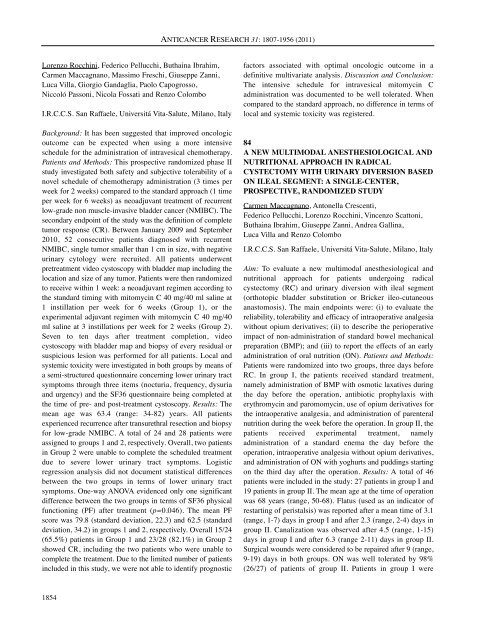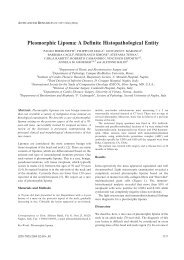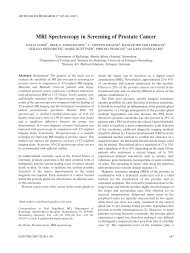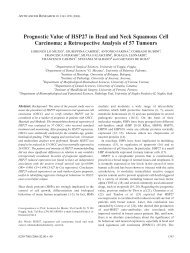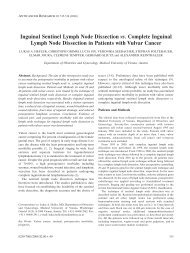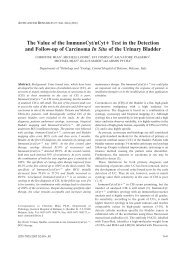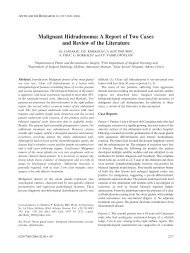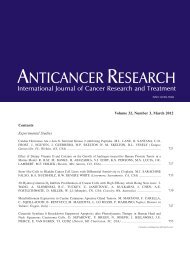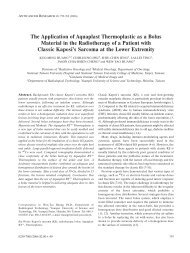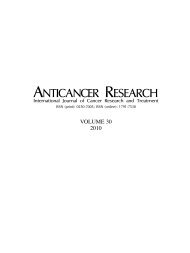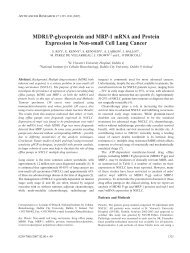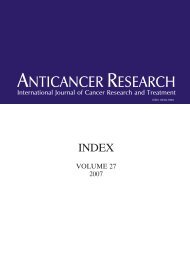ABSTRACTS OF THE 21st ANNUAL MEETING OF THE ITALIAN ...
ABSTRACTS OF THE 21st ANNUAL MEETING OF THE ITALIAN ...
ABSTRACTS OF THE 21st ANNUAL MEETING OF THE ITALIAN ...
You also want an ePaper? Increase the reach of your titles
YUMPU automatically turns print PDFs into web optimized ePapers that Google loves.
Lorenzo Rocchini, Federico Pellucchi, Buthaina Ibrahim,<br />
Carmen Maccagnano, Massimo Freschi, Giuseppe Zanni,<br />
Luca Villa, Giorgio Gandaglia, Paolo Capogrosso,<br />
Niccoló Passoni, Nicola Fossati and Renzo Colombo<br />
I.R.C.C.S. San Raffaele, Universitá Vita-Salute, Milano, Italy<br />
Background: It has been suggested that improved oncologic<br />
outcome can be expected when using a more intensive<br />
schedule for the administration of intravesical chemotherapy.<br />
Patients and Methods: This prospective randomized phase II<br />
study investigated both safety and subjective tolerability of a<br />
novel schedule of chemotherapy administration (3 times per<br />
week for 2 weeks) compared to the standard approach (1 time<br />
per week for 6 weeks) as neoadjuvant treatment of recurrent<br />
low-grade non muscle-invasive bladder cancer (NMIBC). The<br />
secondary endpoint of the study was the definition of complete<br />
tumor response (CR). Between January 2009 and September<br />
2010, 52 consecutive patients diagnosed with recurrent<br />
NMIBC, single tumor smaller than 1 cm in size, with negative<br />
urinary cytology were recruited. All patients underwent<br />
pretreatment video cystoscopy with bladder map including the<br />
location and size of any tumor. Patients were then randomized<br />
to receive within 1 week: a neoadjuvant regimen according to<br />
the standard timing with mitomycin C 40 mg/40 ml saline at<br />
1 instillation per week for 6 weeks (Group 1), or the<br />
experimental adjuvant regimen with mitomycin C 40 mg/40<br />
ml saline at 3 instillations per week for 2 weeks (Group 2).<br />
Seven to ten days after treatment completion, video<br />
cystoscopy with bladder map and biopsy of every residual or<br />
suspicious lesion was performed for all patients. Local and<br />
systemic toxicity were investigated in both groups by means of<br />
a semi-structured questionnaire concerning lower urinary tract<br />
symptoms through three items (nocturia, frequency, dysuria<br />
and urgency) and the SF36 questionnaire being completed at<br />
the time of pre- and post-treatment cystoscopy. Results: The<br />
mean age was 63.4 (range: 34-82) years. All patients<br />
experienced recurrence after transurethral resection and biopsy<br />
for low-grade NMIBC. A total of 24 and 28 patients were<br />
assigned to groups 1 and 2, respectively. Overall, two patients<br />
in Group 2 were unable to complete the scheduled treatment<br />
due to severe lower urinary tract symptoms. Logistic<br />
regression analysis did not document statistical differences<br />
between the two groups in terms of lower urinary tract<br />
symptoms. One-way ANOVA evidenced only one significant<br />
difference between the two groups in terms of SF36 physical<br />
functioning (PF) after treatment (p=0.046). The mean PF<br />
score was 79.8 (standard deviation, 22.3) and 62.5 (standard<br />
deviation, 34.2) in groups 1 and 2, respectively. Overall 15/24<br />
(65.5%) patients in Group 1 and 23/28 (82.1%) in Group 2<br />
showed CR, including the two patients who were unable to<br />
complete the treatment. Due to the limited number of patients<br />
included in this study, we were not able to identify prognostic<br />
1854<br />
ANTICANCER RESEARCH 31: 1807-1956 (2011)<br />
factors associated with optimal oncologic outcome in a<br />
definitive multivariate analysis. Discussion and Conclusion:<br />
The intensive schedule for intravesical mitomycin C<br />
administration was documented to be well tolerated. When<br />
compared to the standard approach, no difference in terms of<br />
local and systemic toxicity was registered.<br />
84<br />
A NEW MULTIMODAL ANES<strong>THE</strong>SIOLOGICAL AND<br />
NUTRITIONAL APPROACH IN RADICAL<br />
CYSTECTOMY WITH URINARY DIVERSION BASED<br />
ON ILEAL SEGMENT: A SINGLE-CENTER,<br />
PROSPECTIVE, RANDOMIZED STUDY<br />
Carmen Maccagnano, Antonella Crescenti,<br />
Federico Pellucchi, Lorenzo Rocchini, Vincenzo Scattoni,<br />
Buthaina Ibrahim, Giuseppe Zanni, Andrea Gallina,<br />
Luca Villa and Renzo Colombo<br />
I.R.C.C.S. San Raffaele, Universitá Vita-Salute, Milano, Italy<br />
Aim: To evaluate a new multimodal anesthesiological and<br />
nutritional approach for patients undergoing radical<br />
cystectomy (RC) and urinary diversion with ileal segment<br />
(orthotopic bladder substitution or Bricker ileo-cutaneous<br />
anastomosis). The main endpoints were: (i) to evaluate the<br />
reliability, tolerability and efficacy of intraoperative analgesia<br />
without opium derivatives; (ii) to describe the perioperative<br />
impact of non-administration of standard bowel mechanical<br />
preparation (BMP); and (iii) to report the effects of an early<br />
administration of oral nutrition (ON). Patients and Methods:<br />
Patients were randomized into two groups, three days before<br />
RC. In group I, the patients received standard treatment,<br />
namely administration of BMP with osmotic laxatives during<br />
the day before the operation, antibiotic prophylaxis with<br />
erythromycin and paromomycin, use of opium derivatives for<br />
the intraoperative analgesia, and administration of parenteral<br />
nutrition during the week before the operation. In group II, the<br />
patients received experimental treatment, namely<br />
administration of a standard enema the day before the<br />
operation, intraoperative analgesia without opium derivatives,<br />
and administration of ON with yoghurts and puddings starting<br />
on the third day after the operation. Results: A total of 46<br />
patients were included in the study: 27 patients in group I and<br />
19 patients in group II. The mean age at the time of operation<br />
was 68 years (range, 50-68). Flatus (used as an indicator of<br />
restarting of peristalsis) was reported after a mean time of 3.1<br />
(range, 1-7) days in group I and after 2.3 (range, 2-4) days in<br />
group II. Canalization was observed after 4.5 (range, 1-15)<br />
days in group I and after 6.3 (range 2-11) days in group II.<br />
Surgical wounds were considered to be repaired after 9 (range,<br />
9-19) days in both groups. ON was well tolerated by 98%<br />
(26/27) of patients of group II. Patients in group I were


